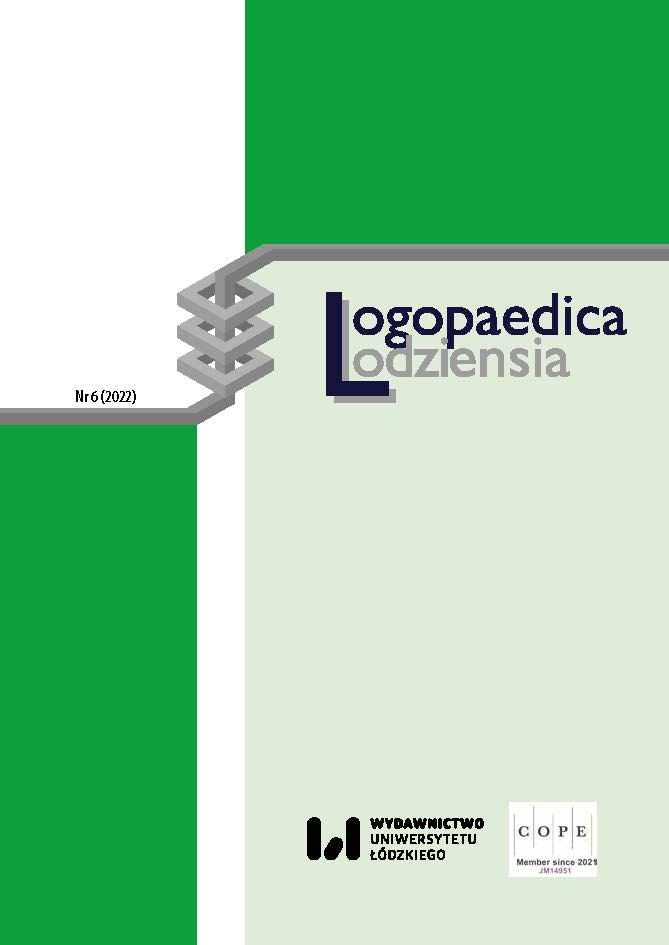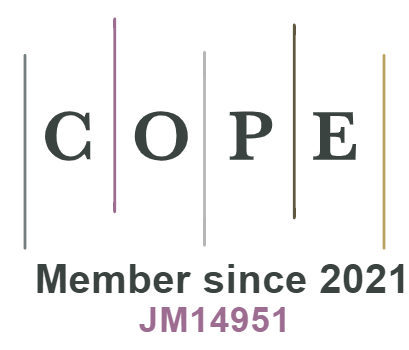SLI or DLD? Changes in Terminology of Speech Disorders with Ambiguous Etiology in the Context of Polish Educational Law
DOI:
https://doi.org/10.18778/2544-7238.06.04Keywords:
specific language impairment (SLI), developmental language disorder (DLD), Polish educational law, terminological difficulties, diagnostic difficulties, a judgment on the need for special educationAbstract
The article has been devoted to speech disorders of unclear ambiguous cause. There are many alternative terms for this type of language communication disorder in the literature. One of them is SLI (specific language impairment). According to the arrangements of international experts it is recommended to depart from SLI to DLD (developmental language disorder). The article presents the rationale behind this solution. At the same time, the consequences of the lack of terms in Polish educational law that define speech disorders occurring without a clear cause were discussed.
Downloads
References
Bielenda‑Mazur E., 2019, Deficyty poznawcze w alalii, „Logopedia”, t. 48(2), s. 205–222.
Google Scholar
Bishop D., 1992, The underlying nature of specific language impairment, „Journal of Child Psychology and Psychiatry”, No. 33, s. 3–66.
Google Scholar
DOI: https://doi.org/10.1111/j.1469-7610.1992.tb00858.x
Bishop D., 1994, Grammatical errors in specific language impairment: Competence or performance limitations?, „Applied Psycholinguistics”, No. 15, s. 507–550.
Google Scholar
DOI: https://doi.org/10.1017/S0142716400006895
Bishop D.V.M., 2014, Ten questions about terminology for children with unexplained language problems, „International Journal of Language & Communication Disorders”, No. 49(4), s. 381–415.
Google Scholar
DOI: https://doi.org/10.1111/1460-6984.12101
Bishop D.V.M., 2017a, Why is it so hard to reach agreement on terminology? The case of developmental language disorder (DLD), „International Journal of Language & Communication Disorders”, No. 52(6), s. 671–680.
Google Scholar
DOI: https://doi.org/10.1111/1460-6984.12335
Bishop D., 2017b, Developmental Language Disorder (DLD): The consensus explained, https://www.slideshare.net/RADLD/developmental‑language‑disorder‑dld‑the‑consensus‑explained (dostęp: 15.06. 2021).
Google Scholar
Bishop D.V.M., Snowling M.J., Thompson P.A., Greenhalgh T., Catalise consortium, 2016, CATALISE: A Multinational and Multidisciplinary Delphi Consensus Study. Identifying Language Impairments in Children, https://doi.org/10.1371/journal.pone.0158753
Google Scholar
DOI: https://doi.org/10.7287/peerj.preprints.1986v1
Bishop D.V.M., Snowling M.J., Thompson P.A., Greenhalgh T., the Catalise–2‑consortium, 2017, Phase 2 of CATALISE: a multinational and multidisciplinary Delphi consensus study of problems with language development: Terminology, „The Journal of Child Psychology and Psychiatry”, No. 58(10), special issue: Developmental Language Disorder, s. 1086–1080.
Google Scholar
DOI: https://doi.org/10.1111/jcpp.12721
Cieszyńska‑Rożek J., 2013, Metoda krakowska wobec zaburzeń rozwoju dzieci. Z perspektywy fenomenologii, neurobiologii i językoznawstwa, Kraków: Wydawnictwo Omega Stage System – Jędrzej Cieszyński.
Google Scholar
Czaplewska E., 2012, Rozumienie pragmatycznych aspektów wypowiedzi przez dzieci ze specyficznym zaburzeniem językowym. SLI, Gdańsk: Wydawnictwo Harmonia Universalis.
Google Scholar
Dilling‑Ostrowska E., 1982, Rozwój i zaburzenia mowy u dzieci w zależności od stopnia dojrzałości układu nerwowego, [w:] J. Szumska (red.), Zaburzenia mowy u dzieci, Warszawa: Państwowy Zakład Wydawnictw Lekarskich, s. 18–30.
Google Scholar
Ebbels S., 2014, Introducing the SLI debate, „International Journal of Language & Communication Disorder”, Vol. 49, No. 4, s. 377–380.
Google Scholar
DOI: https://doi.org/10.1111/1460-6984.12119
Ebbels S.H., Lely H.K.J. van der, Dockrell J.E., 2007, Intervention for verb argument structure in children with persistent SLI. A randomized control trial, „Journal of Speech, Language and Hearing Research”, Vol. 50(5), s. 1330–1349.
Google Scholar
DOI: https://doi.org/10.1044/1092-4388(2007/093)
International Classification of Diseases 11th Revision. The global standard for diagnostic health information, http://icd.who.int/en (dostęp: 12.06. 2021).
Google Scholar
Jastrzębowska G., 2003, Zakłócenia i zaburzenia rozwoju mowy, [w:] T. Gałkowski, G. Jastrzębowska (red.), Logopedia. Pytania i odpowiedzi. Podręcznik akademicki. Zaburzenia komunikacji językowej u dzieci i osób dorosłych, t. 2, Opole: Wydawnictwo Uniwersytetu Opolskiego, s. 9–79.
Google Scholar
Jastrzębowska G., 2016, Co utrudnia opis logopedycznych zjawisk? Od słuchoniemoty, afazji wrodzonej i alalii do specyficznego zaburzenia językowego (SLI), „Stylistyka”, nr XXV, s. 543–554.
Google Scholar
DOI: https://doi.org/10.25167/Stylistyka.25.2016.35
Jastrzębowska G., 2019, Zaburzenia neurorozwojowe. Zmiany w podejściu teoretycznym i diagnostycznym, „Logopedia” t. 48(1), s. 27–46.
Google Scholar
Jastrzębowska G., Jastrzębowska‑Tyczkowska A., Woś A., Stanek K., 2017, Przebieg rozwoju mowy u dzieci z SLI‑PE i LB – analiza porównawcza, „Logopedia”, t. 46, s. 53–72.
Google Scholar
Kielar‑Turska M., 2012, Sprawności językowe i komunikacyjne a inne funkcje psychiczne, [w:] S. Milewski, K. Kaczorowska‑Bray (red.), Logopedia. Wybrane aspekty historii, teorii i praktyki, Gdańsk: Harmonia Universalis, s. 70–86.
Google Scholar
Kordyl Z., 1969, Mowa dzieci afatycznych, „Logopedia”, t. 8/9, s. 16–30.
Google Scholar
Krasowicz‑Kupis G., 2012, SLI i inne zaburzenia językowe, Sopot: Gdańskie Wydawnictwo Psychologiczne.
Google Scholar
Kurcz I., 2000, Psychologia języka i komunikacji, Warszawa: Wydawnictwo Naukowe Scholar.
Google Scholar
Lasota A., 2007, Specyficzne zaburzenie rozwoju językowego, „Sztuka Leczenia”, t. XIV, nr 12, s. 35–45.
Google Scholar
Leonard L.B., 1991, Specific language impairment as a clinical category, „Language, Speech and Hearing Services in Schools”, No. 22, s. 66–68.
Google Scholar
DOI: https://doi.org/10.1044/0161-1461.2202.66
Leonard L.B., 1995, Functional categories in the grammars of children with specific language impairment, „Journal of Speech and Hearing Research”, No. 38, s. 1270–1283.
Google Scholar
DOI: https://doi.org/10.1044/jshr.3806.1270
Leonard L.B., 2006, SLI – Specyficzne zaburzenie rozwoju językowego, Gdańsk: Gdańskie Wydawnictwo Psychologiczne.
Google Scholar
Libura A., Libura M., 2011, Językoznawstwo wobec odkryć genetyki. Na przykładzie niektórych problemów związanych z tzw. genem języka, [w:] P. Stalmaszczyk (red.), Metodologie językoznawstwa. Od genu języka do dyskursu, Łódź: Wydawnictwo Uniwersytetu Łódzkiego, s. 11–26.
Google Scholar
DOI: https://doi.org/10.18778/7525-585-0.02
Maruszewski M., 1974, Chory z afazją i jego usprawnianie, Warszawa: Nasza Księgarnia.
Google Scholar
McGregor K.K., Goffman L., Horne A.O. van, Hogan T.P., Finestack L.H., 2020, Tutorial.
Google Scholar
Developmental Language Disorder: Applications for Advocacy, Research and Clinical Service, „Perspectives”, Vol. 5(1), s. 38–46.
Google Scholar
DOI: https://doi.org/10.1044/2019_PERSP-19-00083
Paluch A., Drewniak‑Wołosz E., Mikosza L., 2003, AFA – skala. Jak badać mowę dziecka afatycznego?, Kraków: Oficyna Wydawnicza Impuls.
Google Scholar
Panasiuk J., 2015, Postępowanie logopedyczne w przypadkach alalii i niedokształcenia mowy o typie afazji, [w:] S. Grabias, J. Panasiuk, T. Woźniak (red.), Logopedia. Standardy postępowania logopedycznego. Podręcznik akademicki, Lublin: Wydawnictwo Uniwersytetu Marii Curie‑Skłodowskiej, s. 309–345.
Google Scholar
Parol U.Z., 1989, Dziecko z niedokształceniem mowy, Warszawa: Wydawnictwa Szkolne i Pedagogiczne.
Google Scholar
Podgórska‑Jachnik D., 2006, Między upośledzeniem umysłowym a niepełnosprawnością intelektualną – dylematy terminologiczne, „Forum Pedagogów Specjalnych XXI Wieku”, t. VII, s. 81–91.
Google Scholar
Rice M.L., Wexler K., 1996, Toward tense as a clinical marker of specific language impairment in English‑speaking children, „Journal of Speech, Language, and Hearing Research”, No. 39, s. 1239–1257.
Google Scholar
DOI: https://doi.org/10.1044/jshr.3906.1239
Rozporządzenie Ministra Edukacji Narodowej z dnia 7 września 2017 r. w sprawie orzeczeń i opinii wydawanych przez zespoły orzekające działające w publicznych poradniach psychologiczno‑pedagogicznych (Dz.U. z 2017 r., poz. 1743), https://isap.sejm.gov.pl/isap.nsf/DocDetails.xsp?id=WDU20170001743 (dostęp: 12.06.2021).
Google Scholar
Smoczyńska M., 2000, Wczesna interwencja u dzieci z opóźnionym rozwojem mowy, [w:] H. Mierzejewska, M. Przybysz‑Piwkowa (red.), Teoretyczne podstawy metod usprawniania mowy. Afazja. Zaburzenia rozwoju mowy, Warszawa: Drukarnia ROXER, s. 45–54.
Google Scholar
Smoczyńska M., 2012, Opóźniony rozwój mowy a ryzyko SLI: wyniki badań podłużnych dzieci polskich, [w:] J. Porayski‑Pomsta, M. Przybysz‑Piwko (red.), Interwencja logopedyczna. Zagadnienia ogólne i praktyka, Warszawa: Dom Wydawniczy ELIPSA, s. 13–37.
Google Scholar
Tomblin J.B., 1991, Examining the cause of specific language impairment, „Language, Speech and Hearing Services in Schools”, No. 22, s. 69–74.
Google Scholar
DOI: https://doi.org/10.1044/0161-1461.2202.69
Tompkins V., Farrar M., 2011, Mothers’ autobiographical memory and book narratives with children with specific language impairment, „Journal of Communication Disorder”, No. 44(1), s. 1–22.
Google Scholar
DOI: https://doi.org/10.1016/j.jcomdis.2010.06.002
Traczyńska H., 1982, Rozwój i zaburzenia czynności ruchowych a funkcja mowy u dzieci, [w:] J. Szumska (red.), Zaburzenia mowy u dzieci, Warszawa: Państwowy Zakład Wydawnictw Lekarskich, s. 31–37.
Google Scholar
Downloads
Published
How to Cite
Issue
Section
License

This work is licensed under a Creative Commons Attribution-NonCommercial-NoDerivatives 4.0 International License.











